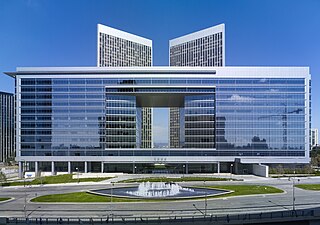Related Research Articles
A hedge fund is a pooled investment fund that trades in relatively liquid assets and is able to make extensive use of more complex trading, portfolio-construction, and risk management techniques in an attempt to improve performance, such as short selling, leverage, and derivatives. Financial regulators generally restrict hedge fund marketing to institutional investors, high net worth individuals, and accredited investors.

In finance, a high-yield bond is a bond that is rated below investment grade by credit rating agencies. These bonds have a higher risk of default or other adverse credit events, but offer higher yields than investment-grade bonds in order to compensate for the increased risk.

A leveraged buyout (LBO) is one company's acquisition of another company using a significant amount of borrowed money (leverage) to meet the cost of acquisition. The assets of the company being acquired are often used as collateral for the loans, along with the assets of the acquiring company. The use of debt, which normally has a lower cost of capital than equity, serves to reduce the overall cost of financing the acquisition.
The Carlyle Group is a multinational private equity, alternative asset management and financial services corporation based in the United States with $376 billion of assets under management. It specializes in private equity, real assets, and private credit. It is one of the largest mega-funds in the world. In 2015, Carlyle was the world's largest private equity firm by capital raised over the previous five years, according to the PEI 300 index. In the 2023 ranking however, it had slipped to fifth place.
In the field of finance, private equity (PE) is an investment fund, usually a limited partnership, which invests in and restructures private companies. A private-equity fund is both a type of ownership of assets and is a class of assets, which function as modes of financial management for operating private companies that are not publicly traded in a stock exchange.

Financial services are economic services provided by the finance industry, which together encompass a broad range of service sector firms that provide financial management, including credit unions, banks, credit-card companies, insurance companies, accountancy companies, consumer-finance companies, stock brokerages, investment funds, individual asset managers, and some government-sponsored enterprises.

A collateralized debt obligation (CDO) is a type of structured asset-backed security (ABS). Originally developed as instruments for the corporate debt markets, after 2002 CDOs became vehicles for refinancing mortgage-backed securities (MBS). Like other private label securities backed by assets, a CDO can be thought of as a promise to pay investors in a prescribed sequence, based on the cash flow the CDO collects from the pool of bonds or other assets it owns. Distinctively, CDO credit risk is typically assessed based on a probability of default (PD) derived from ratings on those bonds or assets.

A syndicated loan is one that is provided by a group of lenders and is structured, arranged, and administered by one or several commercial banks or investment banks known as lead arrangers.

The history of private equity and venture capital and the development of these asset classes has occurred through a series of boom-and-bust cycles since the middle of the 20th century. Within the broader private equity industry, two distinct sub-industries, leveraged buyouts and venture capital experienced growth along parallel, although interrelated tracks.

Collateralized loan obligations (CLOs) are a form of securitization where payments from multiple middle sized and large business loans are pooled together and passed on to different classes of owners in various tranches. A CLO is a type of collateralized debt obligation.

Angelo, Gordon & Co. L.P. is a global alternative investment manager founded in November 1988 by John M. Angelo and Michael L. Gordon who together ran the arbitrage department of L.F. Rothschild in the 1980s.

H.I.G. Capital is a Miami, Florida–based private equity and alternative assets investment firm with $56 billion of equity capital under management. The firm operates a family of private equity, growth equity, credit/special situation, primary lending, syndicated credit, and real estate funds. The company provides both debt and equity capital to small and mid-sized companies.

Private equity in the 2000s represents one of the major growth periods in the history of private equity and venture capital. Within the broader private equity industry, two distinct sub-industries, leveraged buyouts and venture capital expanded along parallel and interrelated tracks.
Venture debt or venture lending is a type of debt financing provided to venture-backed companies by specialized banks or non-bank lenders to fund working capital or capital expenses, such as purchasing equipment. Venture debt can complement venture capital and provide value to fast growing companies and their investors. Unlike traditional bank lending, venture debt is available to startups and growth companies that do not have positive cash flows or significant assets to give as collateral. Venture debt providers combine their loans with warrants, or rights to purchase equity, to compensate for the higher risk of default, although this is not always the case.

Ares Management Corporation is a global alternative investment manager operating in the credit, private equity and real estate markets. The company was founded in 1997 with additional offices across North America, Europe, and Asia.
Blackstone Credit, formerly known as GSO Capital Partners (GSO) is an American hedge fund and the credit investment arm of The Blackstone Group. Blackstone Credit is one of the largest credit-oriented alternative asset managers in the world and a major participant in the leveraged finance marketplace. The firm invests across a variety of credit oriented strategies and products including collateralized loan obligation vehicles investing in secured loans, hedge funds focused on special situations investments, mezzanine debt funds and private equity funds focused on rescue financing.
On March 23, 2009, the United States Federal Deposit Insurance Corporation (FDIC), the Federal Reserve, and the United States Treasury Department announced the Public–Private Investment Program for Legacy Assets. The program is designed to provide liquidity for so-called "toxic assets" on the balance sheets of financial institutions. This program is one of the initiatives coming out of the implementation of the Troubled Asset Relief Program (TARP) as implemented by the U.S. Treasury under Secretary Timothy Geithner. The major stock market indexes in the United States rallied on the day of the announcement rising by over six percent with the shares of bank stocks leading the way. As of early June 2009, the program had not been implemented yet and was considered delayed. Yet, the Legacy Securities Program implemented by the Federal Reserve has begun by fall 2009 and the Legacy Loans Program is being tested by the FDIC. The proposed size of the program has been drastically reduced relative to its proposed size when it was rolled out.
Golub Capital is a credit asset manager based in the United States with over $60 billion of capital under management. The firm has primary business lines in middle market lending, late stage lending, and broadly syndicated loans. The firm is also affiliated with Golub Capital BDC, Inc., a business development company that trades on the NASDAQ under the stock ticker symbol, GBDC. Golub Capital is one of the largest non-bank middle market lenders and providers of senior debt.
Private credit is an asset defined by non-bank lending where the debt is not issued or traded on the public markets. Private credit can also be referred to as "direct lending" or "private lending". It is a subset of "alternative credit".
The corporate debt bubble is the large increase in corporate bonds, excluding that of financial institutions, following the financial crisis of 2007–08. Global corporate debt rose from 84% of gross world product in 2009 to 92% in 2019, or about $72 trillion. In the world's eight largest economies—the United States, China, Japan, the United Kingdom, France, Spain, Italy, and Germany—total corporate debt was about $51 trillion in 2019, compared to $34 trillion in 2009. Excluding debt held by financial institutions—which trade debt as mortgages, student loans, and other instruments—the debt owed by non-financial companies in early March 2020 was $13 trillion worldwide, of which about $9.6 trillion was in the U.S.
References
- ↑ Block, Joern; Young Soo Jang (2022). A Survey of Private Debt Funds (PDF) (Technical report). University of Chicago. 2023-10.
- ↑ Jane Hsu (4 April 2023). Private Debt Investment Update (PDF) (Report). CalPERS.
- ↑ "Cliffwater Direct Lending Index - The Direct Lending Market, Quantified". 4 April 2023.
- ↑ Stothard, Michael (12 March 2013). "Funds lend direct to eurozone groups". Financial Times .
- ↑ Dolan, Charles (2013). "Beyond Banks: The Emerging Opportunity in European Direct Lending" (PDF). The Bank of New York Mellon.
- ↑ Performance Of Private Credit Funds: A First Look (Report). Kenan Institute of Private Enterprise at University of North Carolina. 2 July 2018.
- ↑ "Insurer Legal & General to start lending direct to businesses". Reuters . 17 July 2014.
- ↑ Bisserbe, Noémie (6 April 2014). "Direct Lending Takes Off in Europe". The Wall Street Journal.